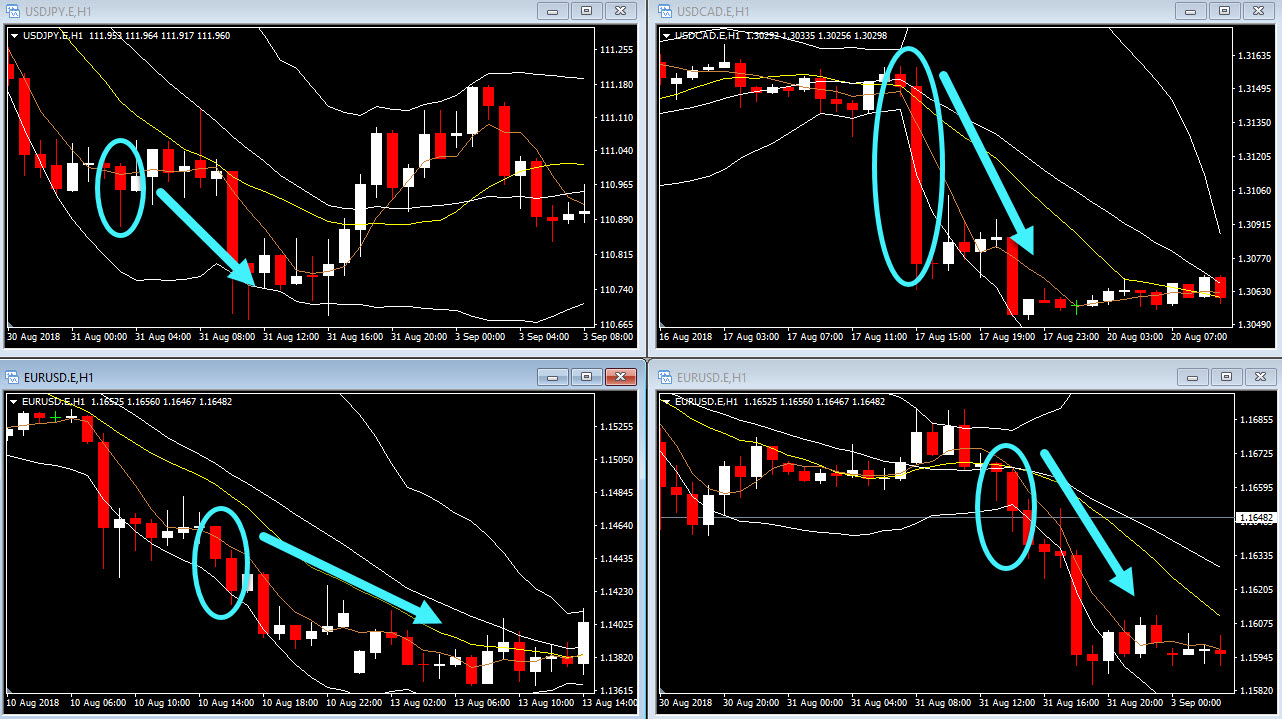Standard economic theory postulates that positive inflation surprises should have a negative effect on the exchange rate. Nonetheless, currencies appear to move in tandem with inflation surprises. In particular, it appears that exchange rates are positively related to inflation surprises, as I will demonstrate with four recent, illustrative, examples:
- August 10, 2018, GMT 12:30. US Core consumer price index comes out at 2.4%, against expectations of 2.3%. The USD appreciates approximately 20 pips against the Euro upon this announcement, and continued to move upwards for the rest of the day.
- August 17, 2018, GMT 12:30. Bank of Canada Core and overall CPI measures show an inflation rate of 1.6% and 3% respectively. The numbers are 0.5% and 0.3% higher than consensus expectations. The CAD appreciates approximately 75 pips with respect to the Dollar and maintains its gains until Monday.
- August 30, 2018, GMT 23:30. The Tokyo Consumer Price Index, a proxy for the overall price level in Japan, registered a 0.4% increase – 1.2% compared to expectations of 0.8%. The fact that the index is only related to one city had its impact, as the USDJPY pair declined by 12 pips upon the announcement, continuing to drop until noon next day.
- August 31, 2018, GMT 09:00. Euro area core and overall CPI come out 0.1% less than what was expected. The EURUSD pair declines 3 pips on the announcement but continues to drop over the following hours, with a full decline of approximately 70 pips.
An interesting question is what drives this behaviour. The answer lies in the fundamentals of inflation. In particular, inflation is governed by supply and demand forces, which move to set the inflation rate. However, there have not been many supply shocks, at least in the last few years, given that the price of oil has more or less fluctuated around $70 since 2006. In addition, taking the US economy as an example, causality tests have shown that, when using core inflation, the bi-directional relationship suggested by the fundamentals of inflation post appears to hold, at least for the 2007-2018 period.* This suggests that the supply shocks to inflation are strictly domestic to the US economy and hence are evened out by the subsequent increase in consumer spending. As such, any change in prices, even from the supply side, will be related to the growth of the real economy.
Consequently, higher inflation in developed economies, i.e. the major currency pairs, should be associated with currency appreciation. While this relationship could change in the coming years, perhaps due to unexpected supply-side changes, at the moment, it appears that the relationship is the opposite of what traditional economic models would suggest.
*In contrast, earnings do not appear to cause the overall (i.e. non-core) inflation rate, most likely due to the fact that the energy and food shares, which are excluded in the core estimate but appear to be affected by wages, are rather large. The Granger causality tests were conducted for the March 2007 – August 2018 period, using a VAR with 3 lags, as suggested by the Schwarz and HQ criteria.
Click here to access the HotForex Economic calendar.
Want to learn to trade and analyse the markets? Join our webinars and get analysis and trading ideas combined with better understanding on how markets work. Click HERE to register for FREE! The next webinar will start in:
[ujicountdown id=”Next Webinar” expire=”2018/09/18 14:00″ hide=”true” url=”” subscr=”” recurring=”” rectype=”second” repeats=””]
Dr Nektarios Michail
Market Analyst
HotForex
Disclaimer: This material is provided as a general marketing communication for information purposes only and does not constitute an independent investment research. Nothing in this communication contains, or should be considered as containing, an investment advice or an investment recommendation or a solicitation for the purpose of buying or selling of any financial instrument. All information provided is gathered from reputable sources and any information containing an indication of past performance is not a guarantee or reliable indicator of future performance. Users acknowledge that any investment in FX and CFDs products is characterized by a certain degree of uncertainty and that any investment of this nature involves a high level of risk for which the users are solely responsible and liable. We assume no liability for any loss arising from any investment made based on the information provided in this communication. This communication must not be reproduced or further distributed without our prior written permission.



















